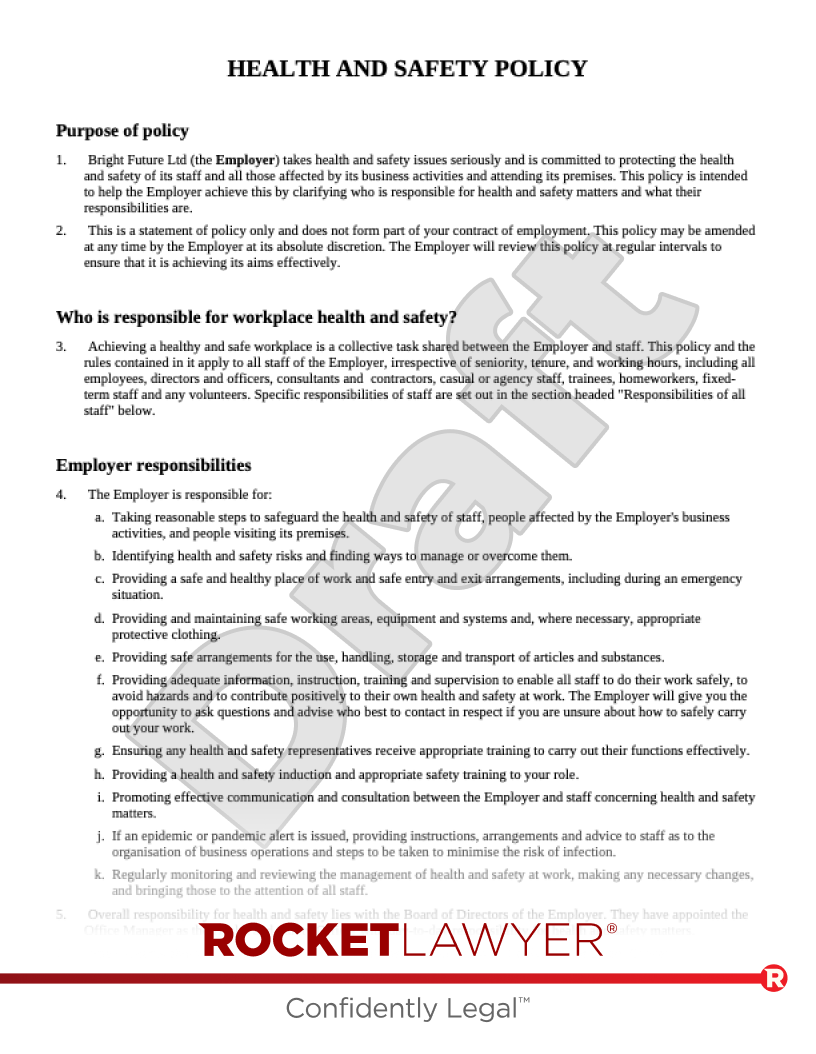What are an employer’s main obligations?
All employers have a general duty to take reasonable steps to ensure the safety of employees and other workers. This covers several areas like providing a safe place of work, safe access to work, safe systems of work, safe equipment, safe and competent fellow workers and protection from unnecessary risks of injury.
All employers must have approved mandatory employer’s liability insurance in place for employee injuries. Employers must conduct and regularly update a risk assessment to identify the measures needed to comply with the applicable health and safety and fire requirements. A separate risk assessment should be done for new and expectant mothers.
All employers must make appropriate health and safety arrangements, appoint a competent person to handle this area and consult with staff over health and safety matters. In addition, if they have five or more employees, having a written health and safety policy is a legal requirement.
Employers must make adequate and appropriate first-aid arrangements and tell staff about them. They must also keep an accident book recording (among other things) all major workplace injuries (including any resulting in hospital treatment) any accident requiring seven days off work or more and other dangerous occurrences.
There are also lots of specific rules about health and safety set out in legislation dealing with particular issues like hazardous chemicals, manual handling, noise, fire, electricity, display screens, manual handling, first aid and accidents. Some high-risk workplaces have special rules (eg construction sites).
For more information visit the HSE website.
What else should you know?
Employees cannot be subjected to any detriment for raising health and safety concerns or carrying out relevant duties as they are protected from being discriminated against under whistleblowing legislation.
Protecting health doesn’t just mean avoiding accidents. Don’t forget to think about the effects of stress, bullying and harassment in your health and safety planning; these issues can also lead to claims of discrimination.
In serious cases of employer default, directors and officers can face criminal charges.
Occupier’s liability
The Occupier’s Liability Act 1984 and the Occupier’s Liability Act 1957 require the person (or people) controlling premises (known as the ‘occupier’) to ensure that anyone who enters the premises (eg business premises) is physically safe. This includes workers and visitors, but may at times also extend to trespassers or other uninvited guests.
The law also imposes a duty of care on occupiers, to ensure that the premises are reasonably safe for visitors, for the purpose that they were invited onto the premises. If there are any specified dangers on the premises (eg heavy machinery operating in certain areas or ponds or lakes on the premises), these must be clearly identified and highlighted to all visitors.
You should take care to comply with the occupier’s liability rules and make sure that you have the relevant insurance in place. Note that this can be costly.
Managing health and safety in practice
Dealing with health and safety issues is daunting for new employers. Many decide to appoint an expert outside consultant to get the right systems in place.
The HSE is a great source of practical information and guidance for employers. The Healthy Working Lives is a great source to create your action plan and for guidance for employers in Scotland.
The Fire Service is a good source of information on fire safety and compliance and will liaise with workplaces to ensure buildings meet appropriate standards.
For office-based businesses, health and safety arrangements needn’t be too complex. The main issues to tackle will be a written policy, fire safety, first aid arrangements, risk assessments, manual handling and use of display screen equipment (DSE).
What if employees work from home?
Employers’ responsibility towards their employees’ health and safety while they work from home remains the same as when they are working in their usual workplace. This includes conducting risk assessments to identify any hazards associated with working remotely and taking measures to mitigate the likelihood of these risks materialising.
For more information on responsibilities relating to working from home, read Employer health and safety responsibilities for staff working from home and Employer first aid obligations for employees working from home.




